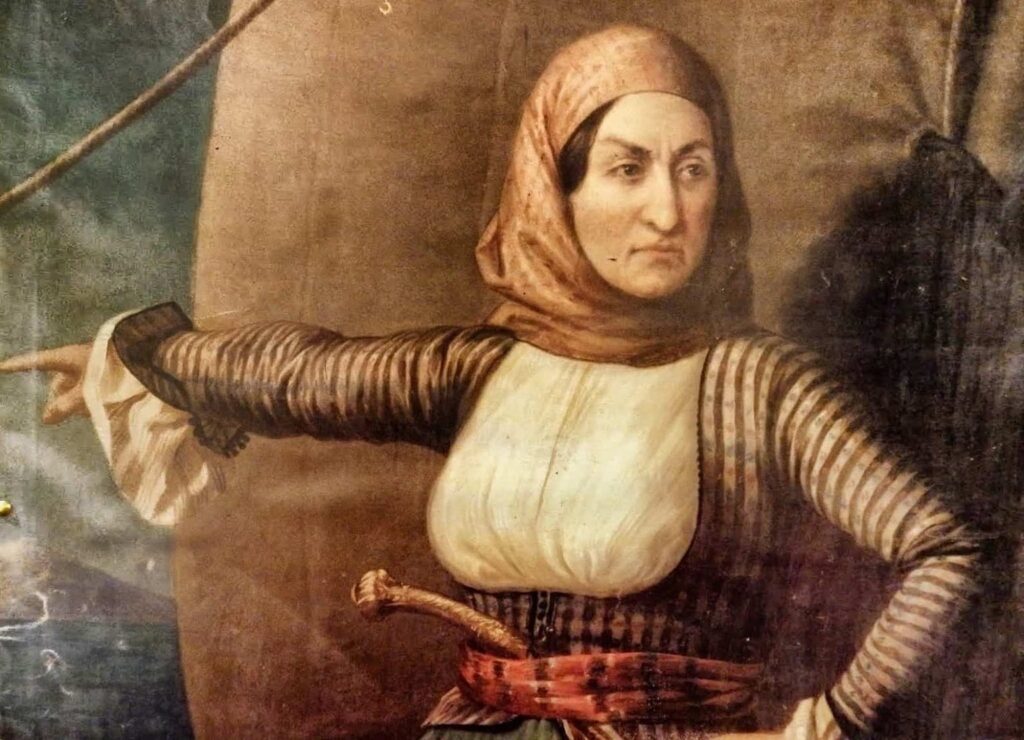As Greece marks the anniversary of its 1821 Revolution on March 25, 2025, the spotlight often falls on the male leaders who spearheaded the uprising against Ottoman rule.
Yet, the contributions of women like Laskarina Bouboulina, Manto Mavrogenous, and the resilient Mesolongitisses were equally vital, showcasing extraordinary bravery, resourcefulness, and dedication to the cause of independence. These women defied societal norms, taking up arms, funding the war effort, and defending their homeland during one of the most pivotal moments in Greek history. Here’s a deeper look at their remarkable stories and the legacy they left behind.
Key Heroines and Their Contributions
Laskarina Bouboulina (1771-1825):
A name synonymous with courage, Laskarina Bouboulina emerged as a formidable naval commander during the revolution. Born into a seafaring family in Constantinople and widowed twice, she inherited significant wealth and a fleet of ships. Bouboulina poured her resources into the war, financing the construction and arming of vessels like the Agamemnon, one of the first Greek warships. Her most celebrated feat came during the siege of Nafplion in 1821, where she led her fleet to blockade the Ottoman-held fortress, cutting off vital supplies. Known for her strategic acumen and fearless leadership, she commanded respect among fighters and became a symbol of resistance until her death in 1825, killed in a family feud. Her legacy endures as a testament to women’s military prowess in the struggle for freedom.

Manto Mavrogenous (1796-1848):
Hailing from a prominent aristocratic family in Trieste, Manto Mavrogenous brought wealth, intellect, and unwavering patriotism to the revolution. Educated and cosmopolitan, she sold her family’s properties and jewelry to fund ships, ammunition, and provisions for the Greek forces. Based on the island of Mykonos, she organized local defenses against Ottoman raids and later joined the fight on the mainland, contributing to key battles. Her letters to European leaders also sought to rally international support for Greece’s cause. Despite her sacrifices, Mavrogenous died in poverty in 1848, having given nearly everything to the war effort. Her selflessness and vision cemented her as a heroine of both action and diplomacy.

The Mesolongitisses:
The women of Messolonghi, known as the “Mesolongitisses,” embody the collective valor of ordinary Greek women during the revolution. In western Greece, Messolonghi endured multiple sieges by Ottoman forces, the most grueling lasting from 1825 to 1826. These women played critical roles, transporting food, water, and ammunition to fighters, nursing the wounded, and even taking up arms when the situation grew dire. During the final exodus in 1826, as the town fell, many chose death over capture, joining men in a heroic last stand. Their resilience under unimaginable hardship remains a powerful chapter in Greece’s fight for independence, honoring the unsung strength of countless women.
Other Notable Figures
Panoria Xatzikonstanti, the Psorokostaina:
A lesser-known but poignant figure, Panoria Xatzikonstanti earned the nickname “Psorokostaina” (a term now synonymous with poverty in Greece) for her selfless acts in the Peloponnese. Legend holds that after losing her family in the war, she begged on the streets not for herself, but to feed and care for orphans left destitute by the conflict. Her story reflects the quiet heroism of women who supported the revolution’s aftermath, ensuring its human cost did not break the spirit of the next generation.

Rallou Karatza, Domna Visvizi, Moscho Tzavela, and the Souliotisses:
Though less celebrated than Bouboulina or Mavrogenous, these women were no less integral to the fight. Rallou Karatza, a cultured noblewoman, used her influence to fund and inspire resistance efforts. Domna Visvizi, a shipowner’s widow like Bouboulina, armed vessels and led maritime operations. Moscho Tzavela, from the fierce Souliot community in Epirus, fought alongside her family, embodying the martial spirit of the region’s women. The Souliotisses, a collective of female warriors from Souli, gained fame for their defiance, most notably in the 1803 Dance of Zalongo, where they leapt off cliffs with their children to avoid enslavement by Ottoman forces. Together, these women highlight the breadth of female involvement across Greece’s diverse regions.
A Legacy of Courage and Sacrifice
The 1821 Greek Revolution was a military triumph and a societal awakening, with women stepping into roles as commanders, financiers, caregivers, and fighters. Their contributions shattered traditional gender boundaries, proving that the quest for liberty knew no limits. From Bouboulina’s naval victories to the Mesolongitisses’ steadfast endurance, these heroines shaped the revolution’s outcome and inspired future generations. As Greece celebrates its independence in 2025, its stories remind us that the fight for freedom was a shared burden, carried with equal valor by the women who stood at the forefront and in the shadows of history.

